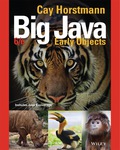
Explanation of Solution
a.
//Definition of class Test
class Test
{
//Definition of method main
public static void main(String[] args)
{
//Initialize the variables
String stars = "*****";
String stripes = "=====";
//Initialize the value of "i" to 0
int i = 0;
//Check the condition using while loop
while (i < 5)
{
//Print the output
System.out.println(stars.substring(0, i));
//Increment the value of "i"
i++;
}
}
}
Explanation:
The above code snippet initializes the variable “i” to “0”. The condition “i<=5” is checked using “while” loop. Print the output and increment the value of “i”.
Output:
*
**
***
****
Explanation of Solution
b.
//Definition of class Test
class Test
{
//Definition of method main
public static void main(String[] args)
{
//Initialize the variables
String stars = "*****";
String stripes = "=====";
//Initialize the value of "i" to 0
int i = 0;
//Check the condition using while loop
while (i < 5)
{
//Print the output
System.out.println(stars.substring(0, i));
//Print the output
System.out.println(stars.substring(i, 5));
//Increment the value of "i"
i++;
}
}
}
Explanation:
The above code snippet initializes the variable “i” to “0”. The condition “i<=5” is checked using “while” loop. Print the output by calling the two sub string function and increment the value of “i”.
Output:
*****
*
****
**
***
***
**
****
*
Explanation of Solution
c.
//Definition of class Main
class Main
{
//Definition of method main
public static void main(String[] args)
{
//Initialize the variables
String stars = "*****";
String stripes = "=====";
//Initialize the value of "i" to 0
int i = 0;
//Check the condition using while loop
while (i < 10)
{
//Check the condition for "i%2" equals to 0
if (i % 2 == 0)
{
//Print the output
System.out.println(stars);
}
else
{
//Print the output
System.out.println(stripes);
}
}
}
}
Explanation:
The above code snippet initializes the variable “i” to “0”. The condition “i<=10” is checked using “while” loop. Inside the while loop, check the condition of “i%2” using the “if” statement.
Output:
*****
*****
*****
*****
*****
*****
*****
.
.
.
.
Infinite loop
Want to see more full solutions like this?
Chapter 6 Solutions
EBK BIG JAVA: EARLY OBJECTS, INTERACTIV
 Database System ConceptsComputer ScienceISBN:9780078022159Author:Abraham Silberschatz Professor, Henry F. Korth, S. SudarshanPublisher:McGraw-Hill Education
Database System ConceptsComputer ScienceISBN:9780078022159Author:Abraham Silberschatz Professor, Henry F. Korth, S. SudarshanPublisher:McGraw-Hill Education Starting Out with Python (4th Edition)Computer ScienceISBN:9780134444321Author:Tony GaddisPublisher:PEARSON
Starting Out with Python (4th Edition)Computer ScienceISBN:9780134444321Author:Tony GaddisPublisher:PEARSON Digital Fundamentals (11th Edition)Computer ScienceISBN:9780132737968Author:Thomas L. FloydPublisher:PEARSON
Digital Fundamentals (11th Edition)Computer ScienceISBN:9780132737968Author:Thomas L. FloydPublisher:PEARSON C How to Program (8th Edition)Computer ScienceISBN:9780133976892Author:Paul J. Deitel, Harvey DeitelPublisher:PEARSON
C How to Program (8th Edition)Computer ScienceISBN:9780133976892Author:Paul J. Deitel, Harvey DeitelPublisher:PEARSON Database Systems: Design, Implementation, & Manag...Computer ScienceISBN:9781337627900Author:Carlos Coronel, Steven MorrisPublisher:Cengage Learning
Database Systems: Design, Implementation, & Manag...Computer ScienceISBN:9781337627900Author:Carlos Coronel, Steven MorrisPublisher:Cengage Learning Programmable Logic ControllersComputer ScienceISBN:9780073373843Author:Frank D. PetruzellaPublisher:McGraw-Hill Education
Programmable Logic ControllersComputer ScienceISBN:9780073373843Author:Frank D. PetruzellaPublisher:McGraw-Hill Education





